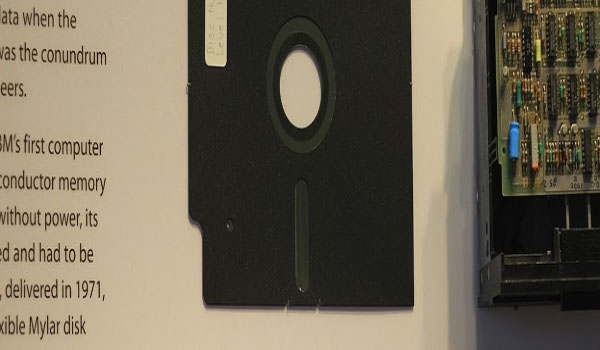America just got a reminder that its nuclear arsenal is old and getting older. On last night’s 60 Minutes, Lesley Stahl met two “missileers” charged with watching over and controlling Minuteman III intercontinental ballistic missiles in Wyoming, and the control room was not what Stahl—or I—expected: There’s no “big button,” but there are floppy disks.
Like the old, big 8-inch floppy disks. Like the kind, pictured above, that are often featured in a computer history museum or found in your attic, beneath old DOS manuals. Like, not even the newer, 3.5-inch model of floppy disk. That’s how they control our nuclear missiles. At 23 years old, the deputy missileer said she had never even seen a floppy disk before finding one that can help wreak untold carnage on planet Earth.
One of the computers that would receive a nuclear missile launch order from the President still uses big floppy disks pic.twitter.com/6SOZ8AExUp
— 60 Minutes (@60Minutes) April 27, 2014
You might be asking, as I did, “Hey, given that this same Lesley mentioned that ‘the warhead on each of these land-based missiles is 20 times more powerful than the bomb dropped on Hiroshima and could kill millions if dropped on a major city,’ we’d want to keep them in tip-top shape, right?” But as it turns out, maintaining a nuclear arsenal is an expensive commitment.
According to a study by the nonpartisan Stimson Center, it would cost at least $352 billion over the next decade to operate and modernize America’s current arsenal. The Minuteman IIIs alone are undergoing a $7 billion upgrade. So, one hopes that the floppies will soon go back to being associated with Number Munchers, rather than a nuclear apocalypse. If you watch the 60 Minutes segment, you’ll notice that the phones are also quite old, though it’s mentioned that they’re “looking at upgrading” them “in the next few years.” A bad connection sure would be an embarrassing way to start World War III. But old phones and floppies are only part of the problem.
Not only are the computers that control the missiles old and controlled by obsolete formats, the information on maintaining the missiles is too. “Irreplaceable nuclear-weapons configuration management information is degrading,” a Department of Energy audit of the National Nuclear Security Administration Nuclear Weapons Systems Configuration Management suggested last month. “Specifically, film media and microfiche are being lost due to degradation, and radiographs are beginning to stick together, causing extensive damage and making the data unrecoverable.”
That’s troubling because without the configuration management information, nuclear warhead parts and components can’t be properly maintained, which “could negatively impact the reliability and safety of U.S. nuclear weapons.”
As Sean Gallager at Ars Technica pointed out, there is an upside to using outdated tech—there’s not a lot of hackers around who have experience breaking into computers from the 1960s.
“A few years ago we did a complete analysis of our entire network,” ICBM forces commander Major General Jack Weinstein told 60 Minutes. “Cyber engineers found out that the system is extremely safe and extremely secure in the way it’s developed.”
That’s a silver lining, my friend.



With the end of Windows XP support, we are suddenly seeing how much of our IT world is running on the cheap. Businesses and the Feds tend to cut costs on computer technology, because it is invisible. The big bucks go to marketing. As far as the missiles, that floppy technology is very slow compared to modern processing hardware.